Error: Contact form not found.

Essential oils have become an integral part of our daily lives, especially in holistic health practices, skincare, and the fragrance industry. However, the essential oils available on the market can vary significantly in terms of quality and intended use. Understanding the different grades of essential oils is essential for ensuring you are choosing the right products for your specific needs. The three primary grades—therapeutic, cosmetic, and fragrance—each serve distinct purposes and have varying levels of purity and quality.
In this blog post, we will break down the differences between these grades of essential oils and help you understand which one is right for you, whether you are looking to benefit from their therapeutic properties, add them to your skincare routine, or simply enjoy their scent.
Before diving into the different grades of essential oils, it’s important to understand what they are. Essential oils are concentrated plant extracts obtained from various parts of plants, such as leaves, flowers, stems, roots, or peels. These oils contain the natural fragrance and beneficial properties of the plant and are typically extracted through methods like steam distillation or cold pressing.
Essential oils have been used for centuries in traditional medicine, aromatherapy, and even in cosmetics. In recent years, their popularity has surged due to their various health benefits, such as stress relief, skin rejuvenation, and antimicrobial properties. However, not all essential oils are created equal, and the grade of oil determines the purity, effectiveness, and safety of the product.
Essential oils are generally classified into three main categories: therapeutic grade, cosmetic grade, and fragrance grade. These classifications indicate the intended use, quality, and purity of the oil. Let’s explore each of these grades in more detail.
Therapeutic grade essential oils are the highest quality oils, intended for use in medical or health-related applications, including aromatherapy, massage, and natural healing practices. These oils are typically 100% pure, undiluted, and free from additives, fillers, or synthetic chemicals. Therapeutic grade oils are carefully extracted using methods that preserve the plant’s beneficial compounds and ensure maximum potency.
If your primary goal is to use essential oils for health and wellness purposes, therapeutic grade essential oils are the best option. They are the oils most commonly used in professional aromatherapy and wellness practices. If you’re using essential oils to relieve stress, improve sleep quality, support immune health, or manage skin conditions, these high-quality oils are your best bet.
Additionally, therapeutic-grade oils can be used in a variety of ways, including massage, topical application (after dilution), or through diffusion. They can also be ingested in specific, safe amounts under the guidance of a healthcare professional.
Cosmetic grade essential oils are of a slightly lower quality than therapeutic grade oils, but they are still highly beneficial and generally safe for use in skincare and personal care products. These oils are typically used in lotions, creams, soaps, and shampoos, or for general body care.
If you’re looking for essential oils to add to your skincare routine or cosmetic products, cosmetic grade essential oils are a great choice. These oils may not provide the same intense therapeutic effects as their higher-grade counterparts, but they still offer numerous benefits for maintaining healthy skin and enhancing the aroma of personal care products.
When purchasing cosmetic grade essential oils, it’s important to look for products from reputable manufacturers to ensure that the oils are safe for topical application. Always check for any potential allergens or irritants, especially if you have sensitive skin.
Fragrance grade essential oils, also known as fragrance oils or perfume oils, are typically synthetic or heavily diluted oils used primarily for their aromatic properties rather than for any therapeutic or cosmetic benefits. These oils are commonly used in the fragrance industry for making perfumes, candles, air fresheners, and other scented products.
If you’re simply looking for a pleasant scent for your home, car, or body care products, fragrance grade essential oils are a suitable option. These oils provide an affordable and long-lasting fragrance, but they should not be used for any therapeutic or skincare purposes.
When purchasing fragrance oils, it’s important to be aware that they may contain synthetic chemicals that could potentially be harmful. If you are sensitive to chemicals or looking for natural alternatives, you may want to opt for essential oils that are labeled as 100% pure.
Choosing the right essential oil grade depends entirely on your intended use:
Understanding the different grades of essential oils is crucial for selecting the right product for your needs. Whether you’re looking to enhance your health with therapeutic-grade oils, improve your skincare routine with cosmetic-grade oils, or simply enjoy a fragrant atmosphere with fragrance-grade oils, knowing the difference will ensure that you make an informed choice.
When in doubt, always opt for the purest and highest quality oils for therapeutic use. If you’re purchasing oils for personal care or fragrance purposes, make sure to choose products from reputable manufacturers that prioritize safety and quality.